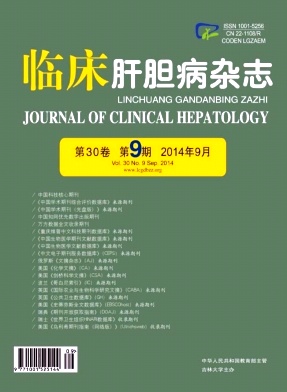|
[1]XU DZ.Clinical practice of viral hepatitis[M].Third Version.Beijing:People's Medical Publishing House, 2006:137-158. (in Chinese) 徐道振.病毒性肝炎临床实践[M].3版.北京:人民卫生出版社, 2006:137-158.
|
|
[2] SIFT M, FU J, SHI F, et al.Transfusion of autologotm cytokitminduced killer cells inhibits viral replication in patients with chronic hepatitis B vius infection[J].Clin Immunol, 2009, 132 (1) :43-54.
|
|
[3]SU HB, SHI M, MOU JS, et al.Effect of adoptive immunotherapy with autologous cytokine-induced killer cells on liver function in patients with chronic HBV infection[J].Chin Hepatol, 2007, 12 (2) :131-132. (in Chinese) 苏海滨, 施明, 牟劲松, 等.自体细胞因子诱导杀伤细胞过继性免疫治疗对慢性HBV感染患者肝功能的影响[J].肝脏, 2007, 12 (2) :131-132.
|
|
[4]LI YY, SHI M, ZHANG B, et al.Research of the function of dendritic cell subsets in chronic hepatitis B patients after retransfusion treatment with autologous CIK cells[J].Infect Dis Info, 2008, 21 (2) :112-114. (in Chinese) 李元元, 施明, 张冰, 等.细胞因子诱导的自体杀伤细胞回输治疗慢性乙型肝炎患者树突状细胞功能的研究[J].传染病信息, 2008, 21 (2) :112-114.
|
|
[5]Chinese Society of Hepatology, Chinese Society of Infectious Diseases, Chinese Medical Association.The guideline for prevention and treatment for chronic hepatitis B (2010 version) [J].J Clin Hepatol, 2011, 27 (1) :Ⅰ-ⅩⅥ. (in Chinese) 中华医学会感染病学分会和肝病学分会.慢性乙型肝炎防治指南 (2010版) [J].临床肝胆病杂志, 2011, 27 (1) :Ⅰ-ⅩⅥ.
|
|
[6] Ministry of Health.Regulation on the clinical application of medical technology[M].Beijing:Ministry of Health of the People's Republic of China, 2009. (in Chinese) 卫生部.医疗技术临床应用管理办法[M].北京:中华人民共和国卫生部, 2009.
|
|
[7]LIN XF, WU JM, LIN CJ, et al.Effeets of HBV S-ecdCD 40L fusion gene modification on function of dendritic cells[J].J Med Res, 2013, 42 (12) :49-53. (in Chinese) 林贤凡, 吴金明, 林春景, 等.HBV S-ecdCD40L融合基因修饰对树突状细胞功能的影响[J].医学研究杂志, 2013, 42 (12) :49-53.
|
|
[8]SHI M, WANG FS, ZHANG B, et al.Evaluation of safety and efficiency of treatment with autologous cytokine-induced killer cell for hepatocellular carcinoma[J].Med J Chin PLA, 2004, 29 (4) :333-335. (in Chinese) 施明, 王福生, 张冰, 等.自体CIK细胞治疗肝癌的安全性和有效性评价[J].解放军医学杂志, 2004, 29 (4) :333-335.
|
|
[9]WANG W, ZHENG HW, REN GF, et al.Differential profiles of T-cell subsets are present in peripheral bolld of patients with various progressive forms of hepatitis B infection[J].J Clin Hepatol, 2013, 29 (4) :276-278. (in Chinese) 王慰, 郑欢伟, 任桂芳, 等.慢性HBV感染及其相关肝病患者外周血T细胞亚群的变化[J].临床肝胆病杂志, 2013, 29 (4) :276-278.
|
|
[10]HUANG J, CHEN ZY.Dynamic observation of cytokine-induced killer cells in peripheral blood from patients with chronic hepatitis B[J].Chin J Cell Mol Immunol, 2003, 19 (6) :554-556. (in Chinese) 黄俭, 陈作严.慢性乙型肝炎患者外周血细胞因子诱导的杀伤细胞的动态观察[J].细胞与分子免疫学杂志, 2003, 19 (6) :554-556.
|
|
[11] XIAO Q, ZHANG LL, SHEN BJ.Research advances in cord blood cytokine induced killer cells[J].Int J Pediatr, 2011, 38 (5) :500-501. (in Chinese) 肖琼, 张乐玲, 沈柏均.脐血CIK细胞的研究进展[J].国际儿科学杂志, 2011, 38 (5) :500-501.
|
|
[12]DENG HF, LU MY, XU B, et al.Detection of survival time of cytokine-induced killer cells in vivo by specific DNA probes[J].Chin J Exp Surg, 2011, 28 (11) :1983-1985. (in Chinese) 邓海峰, 陆明阳, 徐斌, 等.特异性DNA探针检测细胞因子诱导的杀伤细胞在患者体内的生存时间[J].中华实验外科杂志, 2011, 28 (11) :1983-1985.
|
|
[13]LAI N, LIU Q.Progress in adoptive immunotherapy for chronic hepatitis B[J].Chongqing Med J, 2002, 31 (11) :1119-1121. (in Chinese) 赖宁, 刘杞.慢性乙型肝炎过继免疫治疗的进展[J].重庆医学, 2002, 31 (11) :1119-1121.引证本文:LIU B, DONG J, ZHANG JF, et al.Efficacy and safety of UCB-derived or autologous CIK cells combined with interferon therapy in patients with chronic hepatitis B[J].J Clin Hepatol, 2014, 30 (9) :869-872. (in Chinese) 刘波, 董静, 张骏飞, 等.脐血来源或自体细胞因子诱导的杀伤细胞联合干扰素治疗慢性乙型肝炎的安全性和有效性分析[J].临床肝胆病杂志, 2014, 30 (9) :869-872.
|













 DownLoad:
DownLoad: